Occam's Razor
by Avinash Kaushik.
Best Metrics For Digital Marketing: Rock Your Own And Rent Strategies
 In a world of infinite choice, the ability to pick critical few metrics to focus on is, well…, critical. It is the difference between plodding along, or winning big.
In a world of infinite choice, the ability to pick critical few metrics to focus on is, well…, critical. It is the difference between plodding along, or winning big.But choosing what to focus on is extremely hard.
You have to have a deeper understanding of the business, an expansive knowledge of what is possible (and not just inside Google/Adobe Analytics), and, this is so, so, so important, the ability to balance the now and the near future.
We all, myself included, fail so often because of the difficulty inherent in those three elements. In many cases we don't have sufficient knowledge for one and three, even if we are ok with two. And that's not because we stink. It is because often we are just the data girls/boys.
I recently had an opportunity to recommend to a group of CEOs everything they should measure for everything they should do with digital. You can imagine, in a world of infinite choice (!), this is a non-trivial challenge. I wanted the end product to be a handy-dandy list they can use to check if their employees are focused on the right things.
In this post I want to share that one-page list of the best metrics for digital content, marketing and business success with you. I hope the metrics will be helpful, but more than that I hope that the thinking behind whittling down from the infinite to the finite will be of value. If you get the think, you can definitely go out and create your own list of the critical few.
Ready to rock and roll?
Context #1: A Reminder About the Importance of ABO.
I believe in always focusing on the complete customer-business journey. In earlier posts on this blog, I've simply defined the journey as Acquisition, Behavior and Outcomes.
Each stage focuses on a unique facet of the digital business…
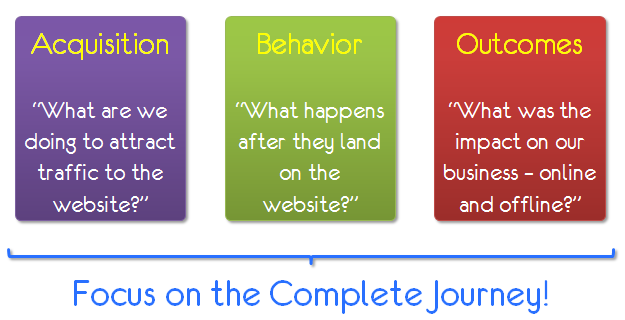
Most of the time when I look at the dashboards and reporting efforts in companies, they are usually obsessed with one of these pieces or maybe even a couple. Rarely is there an insane obsession with all three. Some of this is because we are organized in silos, no incentive to think end-to-end. At other times it is because of a lack of skill or the ability to analyze the complete journey.
Focus on all three with everything you do with digital analytics. Strive for a a balance across all three in terms of people, processes, and analytical focus.
One good way to accomplish that is to ensure you have an optimal org design, and that your Digital Marketing and Measurement Model exemplifies this balance.
Context #2: Own + Rent = Great Digital Success
I believe that if you want to win in digital, with your ABO strategy, you have to do Own really well and you have to do Rent really well.
[Bonus reading: Rent or Own? The Optimal Digital Investment Strategy]
Your primary owned channel is your website, mobile or desktop. It could also include your blog, your recommendation engines, your customer forums, and all kinds of other digital existences that you own outright. You own the domain. You own the customer relationships. You own decisions around content, creativity and evolution. You. Everything.

If you want to win on the web, you have to do both Own and Rent really well. You pretty much don't have a choice. But if you are going to suck at something, sucking at rent is preferable.
Best Digital Metrics: Own Existences/Strategies.
Close your eyes and just imagine the number of metrics you can use to measure the success of your marketing efforts. 25? 50? 68? More?
It would not surprise me. We have so many, and it is not that they are terrible. It's just that there are so many and I set myself the challenge to just focus on two metrics each for acquisition, behavior and outcomes. Just two.
Can you feel my pain? How can we just pick two? #omg
For acquisition my goal was to pick two metrics that would incentivize our teams to behave in the most optimal manner. I abandoned CPC (I hate that metric, it incentivizes short-term thinking of the worst kind). I even abandoned CPA (not enough focus on what makes the ads good). And many others.
I settled on Clicks and Assists.
Clicks because in this case I'm more obsessed about performance marketing. Clicks will get you and I to focus on ad copy, bids, other creative elements, precise targeting (or retargeting), ad placement (quality score for search!), and so many other things that go into making sure that our ad does not simply show up to the party but also entices a physical reaction (Click!).
Assists because most marketers continue to exhibit suicidal tendencies by sticking with last-click attribution. The best way to stink at digital today is to do last-click attribution (and the analytics vendors don't help, last-click is default… they want us to go out of business!).
I want you to focus on % Assists as your standard metric for marketing success (best place to find it is in the Google Analytics MCF Assisted Conversions report). Reward campaigns (owned, earned or paid) that deliver the person who converts right away AND the campaigns who deliver the people who convert after a few days. Assists incentivizes the right behavior by your marketers.
[Bonus read: Multi-Channel Attribution Modeling: The Good, Bad and Ugly Models]
For Behavior, I picked Bounce Rate and Visitor Loyalty.
Bounce Rate to encourage an obsession with landing pages. Far too often with our ads we write checks that our site can't cash. Far too often the Marketer's are paid on ad metrics and not what happens on the site. I want to fix that. Hence Bounce Rate. Create great landing pages, ensure there is clear continuity between your ad, link, email campaign, social contribution, press release, and the place you are sending the traffic to.
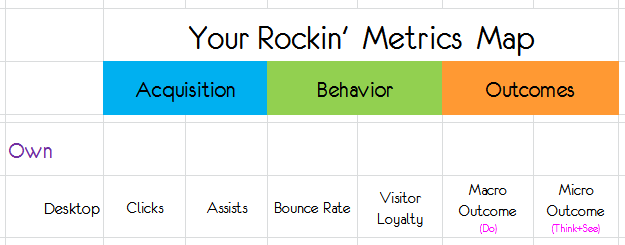
Best practice: Look at your Visitor Loyalty report, pick the number that is most optimal for your business (say, more than 5 times in 30 days) and set that as your target. Now measure like crazy!
I hope you noticed that the behavior I'm encouraging with Visitor Loyalty is the reason why % Assists is such an important metric as well.
You get people to stay for more than one page during their first visit… and get them to visit your site multiple times… how can you not win!
[Bonus read: See-Think-Do: A Content, Marketing, Measurement Business Framework]
Finally for Outcomes, I choose my absolute favorites: Macro and Micro-Outcomes.
The best websites in the world have a portfolio of outcomes (in case your customers are not ready to jump into bed with you right away!). Some of these outcomes add value to the business in the next 30 days, some over 90 days and some over nine months. The portfolio empowers you to solve for every type of customer, and let them move at the pace they are most comfortable with.
You are not going to be successful if your owned digital existence does not have a portfolio of outcomes, here's an example for a casino/destination…
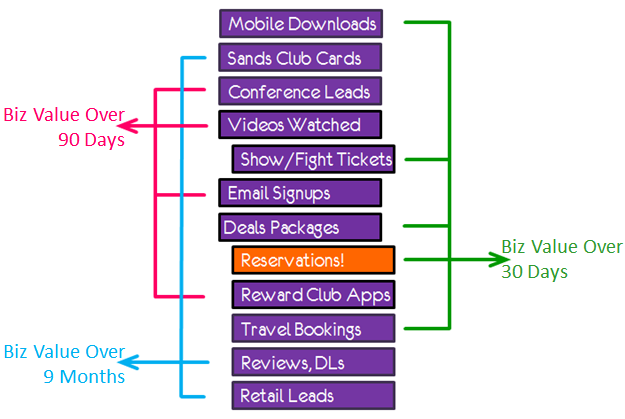
Macro-Outcomes help you measure immediate success, over 30 days. Notice even this is a small collection and not just one conversion.
Micro-Outcomes ensure that there is long term thinking in your company, the best kind of thinking, and that your employees undertake efforts to drive business value from every visit to the site.
Six simple critical few metrics that balance for the short and the long term, that incentivize the right behavior by our peers and agencies. And all standard metrics in any decent web analytics tool.
[Bonus read: Excellent Analytics Tip #24: Obsess About Real Business Profitability]
Let's focus on the other owned asset we have as a company, mobile.
If you've been to one of my keynotes recently you might have heard me recommend a mobile only strategy, and not a mobile first strategy. We have so much progress to make in that area. With mobile becoming the first (or even primary) digital touch-point for our customers, we have to have an insane amount of focus in this area.
[If you are short on ideas for mobile greatness: Mobile Marketing 2015: Rethink Customer Acquisition, Intent Targeting.]
For mobile Acquisition, our critical few metrics stay the same. Clicks and Assists.
Commercial user behavior on mobile is still transient rather than persistent, so you might initially get a lot more value with a focus on Clicks. After that, having thought long and hard about this choice, I still recommend keeping Assists. One day when cross-device tracking/analytics is easier (it is way too hard today), you'll be ready.
For Behavior, I have Bounce Rate and Time Spent.
Bounce Rate is even more important for Mobile, the back button is hard coded into the mobile device! (At least for Android.) You stink and they'll be gone in 0.05 seconds.
Again, because of the transient nature of mobile behavior, I made a switch from Visitor Loyalty to Time Spent. In most cases people will visit your site for a specific purpose (even more so on phones than tablets), create experiences that answer questions and get them to spend the time it takes them to have a successful visit.
The exception is a content site (my beloved New Yorker as an example). For their mobile site, I would keep Visitor Loyalty.
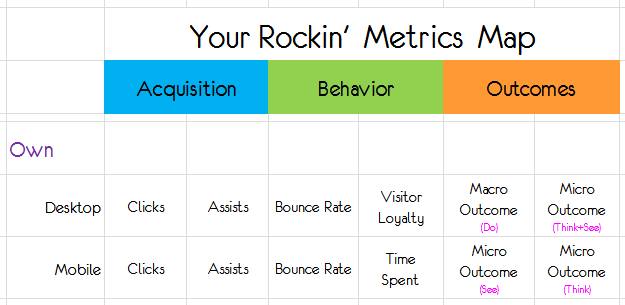
A gigantic reason for under-investment in mobile innovation is the belief by businesses that they can't make money fast ("look, low conversions!"). That is a big mistake. Hence my recommendation to focus on Micro-Outcomes. Those metrics will incentivize the right behavior.
Though we segment Own into two pieces, you'll notice we only ended up with just seven metrics. Focus FTW!
Now let's go see what we can do for Rent.
Best Digital Metrics: Rent Existences/Strategies.
Our goals, participation options and desired outcomes all change for our Rent existences. Much less conversion driven, much more brand marketing driven, and much more longer term focused in terms of impact and outcome.
Most businesses and Marketers have sub-optimal results from their Rent efforts when they are primarily conversion driven, primarily focused on performance marketing and primarily looking for short-term impact.
In choosing the metrics, those elements were top of mind for me. (And I encourage you to keep that strategic view and purpose in mind as you choose your own.)
I've broken Rent channels into permanent and temporary. YouTube is an example of a permanent outpost. This is because for most videos uploaded on YouTube often over 70% of the views will come 30 days after you upload them. Your presence and contributions have a long life. While on temporary outposts like Google+ or Facebook your content, by most measures, "lives" for less than 60 mins – with a small trail of activity for 24 hours and then poof (!) it's gone. For Twitter, it is much, much, shorter than 60 mins/24 hrs.
Yes, on permanent and temporary channels your contributions (text, links, videos, contests, pimping) are always there. It is good for a little SEO. It does have other value (like people randomly bumping into your Twitter page). But almost all engagements your business will have, if any, will be on the latest content. Keep that in mind as you choose what to focus on.
For Acquisition, advertising you buy on YouTube, the metrics to use would be Impressions and Click-thru Rate.
Impressions because in this case a big objective is to solve for brand marketing, so getting a high share of voice is important. (Doing TV on YouTube!)
Click-thru Rate to give a tiny amount of incentive to extend the conversation beyond just the initial impression. CTR will encourage a focus on any commercial purpose of the ad, and creation of a great experience (on YouTube or your Owned channels).

Views because the primary front of our existence are our delightful non-boring videos. We want to encourage consumption of that content to enhance brand perception and move the brand equity up a few points.
But Views by themselves can drive sub-optimal behavior in Marketers. We counter-balance that with Completes . It will encourage a focus on video content, its ability to retain attention and, if we rock, will drive the outcome metrics.
For Outcomes, YouTube is not focused on conversions/short-term outcomes. We focus on driving organic Views (and Complete!) via Social Amplification of content. There is nothing that works better for brand marketing then getting other people to take your content, slap their own name on it and help you reach their friends/lovers/followers – an audience you might not otherwise reach.
And we focus on one of the most precious thing you can get from an audience on any rent channel: Attention! In this case measured via the growth in Subscribers . In study after study we have seen that your Subscribers are the ones who view your content on YouTube first, and their ability to help you out with the initial social amplification is the difference between a pin dropping in a forest or lighting the initial flames of, wait for it…. wait for it…. wait…. viralness!
Subscribers are your biggest fans, you earn more of them, your life becomes exponentially easier over time because you don't have to keep renting audiences via advertising (though please buy advertising, people who work at YouTube have bills :)).
[Bonus Read: Only three things work on YouTube, learn more about them... YouTube Marketing And Analytics: A Primer For Magnificent Success]
Home stretch, measuring our Temporary rent existence/strategies.
This is a bit harder because while there is some commercial intent we can tap into (regardless of if we are a news site or an ecommerce/lead gen site), it is extremely difficult to grab attention (very short half-life of your contributions). You have to deal with things like EdgeRank, or the faster-flowing-everyday river that is your customer's Twitter stream.
I must have mentioned somewhere in this post that picking your critical-few is hard work!
For Acquisition, advertising we buy on Twitter, Facebook etc, my choices were Impressions and Likes/+1s.
Impressions, see above section on our permanent presence.
Likes/+1s is interesting, is it not? This was really hard. Why would you advertise on your temporary social channels? It turns out there is almost no commercial intent (or at least 43 times lower than email campaigns, see this graph – and click Follow!). My recommendation is to focus on getting outcomes on your social presence. Measure Likes/+1s at a post/brand page level. Pure brand marketing with a pinch of engagement on your rent channel.
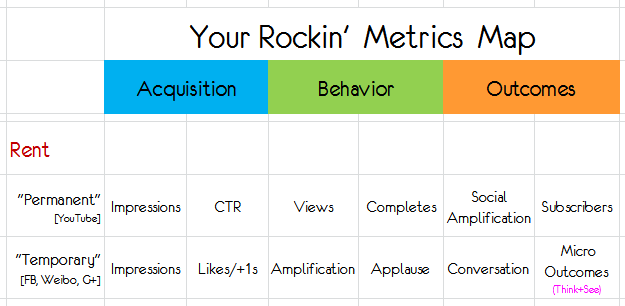
Amplification Rate measuring the number of Shares (Retweets, Forwards etc) on each post. Our goal is to create content that allows you to reach your second-level network. And when people amplify your content, they do so with their own brand endorsement. #awesome
Applause Rate measures the number of Likes (or +1s, Favorite clicks) on each post. It is very hard to know when you are creating content (text, links, videos, images etc) of value. Applause rate is your audience telling you what they like more and what they like less. Focus on the more content and not on the less content. :)
For Outcomes, we are going to focus on Conversation and Owned Micro-Outcomes.
Conversation Rate measures the number of audience comments (or replies) on each post. We are renting these spaces, creating amazing content, doing great brand marketing while participating in and initiating great conversations. So, let's just measure that. Do we create content that creates conversation? If not, why are we on social channels? Great outcome to measure.
Micro-Outcomes measures the outcomes that deliver value to your business over 90 days and over nine months. (For more, please see the Own section above.) This should incentivize our teams to focus on creating long term value on temporary rent channels.
[Bonus read: Best Social Media Metrics: Conversation, Amplification, Applause, Economic Value]
[Bonus read: Facebook Advertising / Marketing: Best Metrics, ROI, Business Value]
If you want to measure the social metrics mentioned above automatically, including Micro-Outcomes, you can do so using the True Social Metrics tool.
Best Digital Metrics: Comprehensive View.
Here's the complete picture from my keynote, the best digital metrics to measure the effectiveness of our ability to find the optimal customers (current, future), influence them and deliver win-win outcomes…
While it looks like a lot, I've recommended just fifteen metrics to measure everything you could possibly to with digital for your business. Not bad, right?
Please click on the image above to see a higher resolution version, or if you want to download it.
Closing Thoughts.
We are blessed with Big BIg BIG data, and many, Many, MAny, MANY metrics! It is our ability to identify the critical few spectacularly relevant metrics to focus on that will bring personal glory to us and professional glory to our business. (Mostly it is about personal. :))
In choosing metrics you have to make trade-offs, some are painful. More than learning about the best metrics available to us, I hope you've learned about the thought process behind each choice. Why something was chosen? What behavior it will drive in our teams/clients?
And one more thing… please remember that this is a journey and not a destination. The Web Metrics Lifecycle Process is Define > Measure > Analyze > Action > Improve or Eliminate. Rinse and repeat. Make sure you remember that (and follow the process!) before you spend so much time in discussion and choosing that the optimal time to deliver insights has passed you by.
Good luck!
As always, it is your turn now.
Does your current dashboard optimally cover Acquisition, Behavior and Outcomes? When discussing a framework to ensure you have the right metrics, does your company use the Own and Rent philosophy? Would you recommend a different set of metrics for ABO for mobile? What do you use to measure the success of your YouTube efforts? How about the temporary social channels like Google+ or Facebook? Is there a metric you consider your absolute BFF that is missing from the choices above?
Please share your advice, insights, questions, critique, ah-ha moments via comments below.
Thank you.
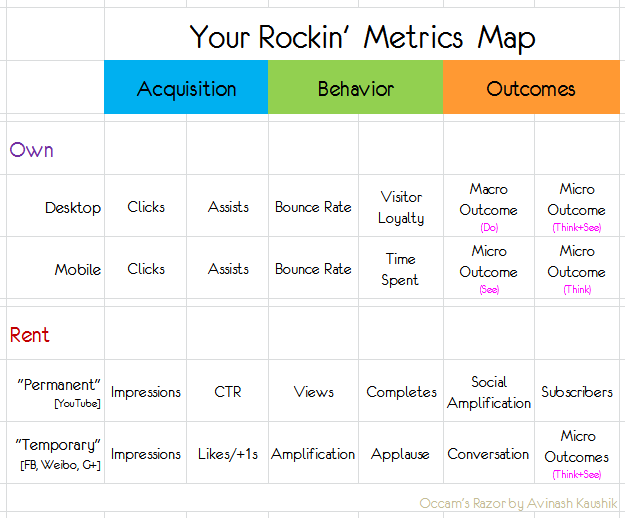
No comments:
Post a Comment